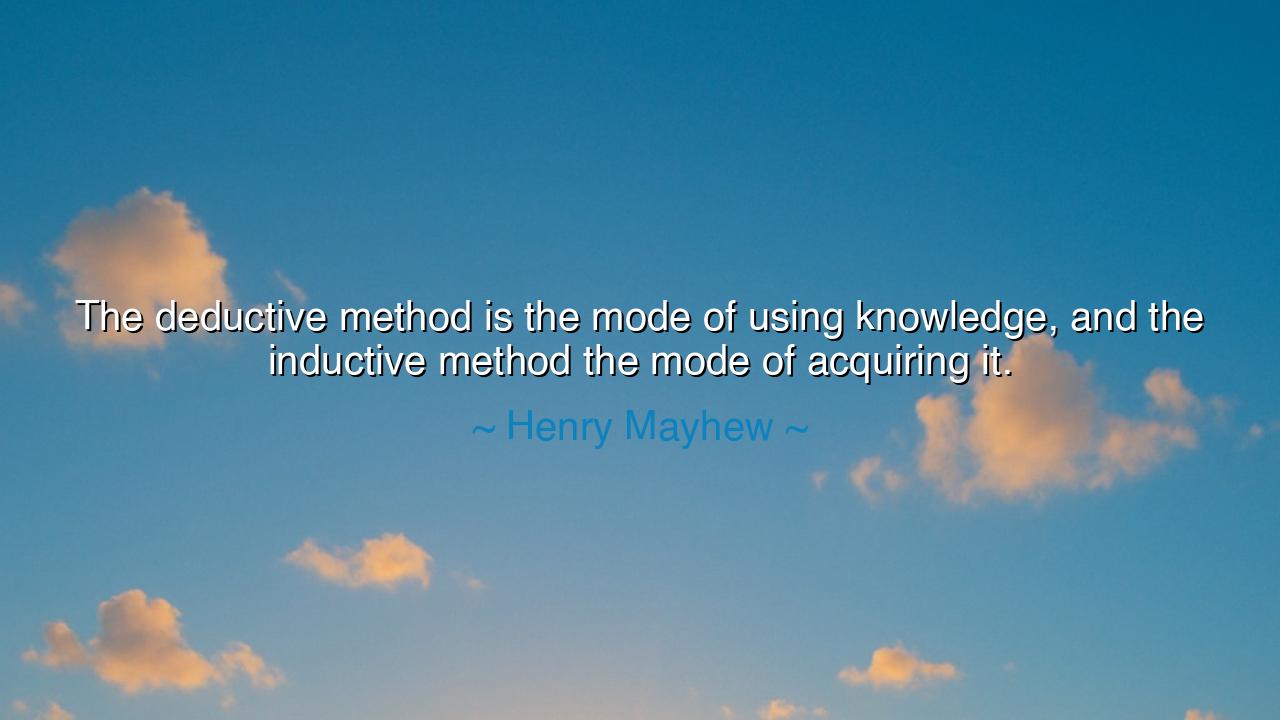
The deductive method is the mode of using knowledge, and the
The deductive method is the mode of using knowledge, and the inductive method the mode of acquiring it.






“The deductive method is the mode of using knowledge, and the inductive method the mode of acquiring it.” Thus spoke Henry Mayhew, a writer and social observer of great depth, whose mind wandered between the worlds of science, philosophy, and human understanding. In this statement, he captures one of the eternal truths of learning — that knowledge is both a river and a wellspring, both the fruit and the seed. Induction and deduction are the two movements of that great dance: one reaching upward from experience to understanding, the other descending from understanding to action. To grasp this dual rhythm is to understand the very heartbeat of reason itself.
In induction, the human mind begins as an explorer, gathering fragments of truth from the vast wilderness of experience. It observes, tests, and compares; it learns by touching the world. The child who places their hand in water, the scientist who watches the stars, the philosopher who listens to the patterns of life — all are guided by induction, by the sacred art of discovery. Through countless observations, the mind begins to perceive the invisible laws that bind the visible world. It moves from the particular to the universal, from the scattered dust of experience to the crystal of insight. Thus, the inductive method is the path by which humanity acquires knowledge — slowly, humbly, and with patience born of wonder.
But when knowledge has been gathered and shaped into form, a new movement begins: deduction, the art of applying what has been learned. From general truth, we descend again into the realm of the specific. We take principle and make it practice. The architect takes the laws of geometry and builds a cathedral. The physician takes the principles of anatomy and heals the sick. The poet takes the eternal patterns of language and breathes them into song. Thus, deduction is the act of using knowledge — the moment when wisdom, once abstract, becomes a force within the world.
Mayhew’s insight reminds us that the two methods are not enemies but companions, forever turning within one another like day and night. Without induction, man would have no light to guide his reason; without deduction, that light would never warm the world. Together they form the sacred cycle of learning — the ascent toward understanding, and the descent toward creation. The one is the quest, the other the fulfillment. To know this balance is to walk the path of the wise.
Consider the life of Isaac Newton, the great mind who stood at the meeting point of these two methods. When he saw the apple fall from the tree, he began with induction — observing nature, questioning the heavens, gathering evidence of how bodies move. But once the law of gravitation revealed itself, he turned to deduction, using that law to explain the tides, the motion of the planets, the dance of the stars. From observation came understanding; from understanding came power. In Newton’s hands, Mayhew’s truth was made visible — that the mind which learns by induction may command by deduction, and that the two together give rise to civilization itself.
Yet, my children, there is a deeper lesson here still. In life, as in thought, we must learn before we act, and act upon what we have learned. Too many rush to deduce — to judge, to decide, to build — before they have truly observed. Others gather endlessly, but never use what they know. The wise balance both: they observe patiently and act boldly; they listen to the world, then speak with purpose. For in every human endeavor — art, science, governance, or the shaping of the soul — induction gathers the truth of the world, and deduction brings that truth to life.
So remember this, my children: let your curiosity be inductive, but your action deductive. Learn from the world with open eyes, then return your knowledge to the world with open hands. Do not seek only to collect facts, for facts alone are pebbles without pattern; and do not seek only to apply rules, for rules without truth are hollow. Instead, walk the sacred bridge between discovery and understanding. Let your knowledge flow like a river — springing from the well of observation and spreading forth to nourish creation.
For as Henry Mayhew teaches, the inductive method is the birth of knowledge, and the deductive method its destiny. One teaches us to see the world; the other teaches us to shape it. When both are held in harmony, the human spirit becomes not merely a student of the universe, but its conscious participant — a co-creator in the endless unfolding of truth.






AAdministratorAdministrator
Welcome, honored guests. Please leave a comment, we will respond soon